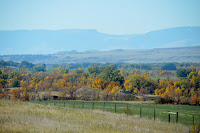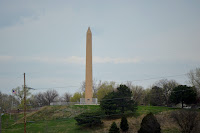*Critters we’ve seen on our 2015 trip so far: elk, mule, mule
deer, llama, prairie dog, donkey, bison, coyote, pronghorn, Uinta ground
squirrel, black bear, moose, bighorn sheep, yellow-bellied marmot, wolf, least
chipmunk, fox, bull snake, mountain goat, camel, grizzly bear
*Birds we’ve seen on our 2015 trip so far: California
condor, Brewer’s blackbird, American kestrel, spotted towhee, magpie, wild turkey, mountain bluebird,
bald eagle, Canada goose, Clark’s nutcracker, sandhill crane, osprey,
red-tailed hawk, mountain chickadee, Northern flicker, great horned owl,
Peregrine falcon, brown-headed cowbird, cliff swallow, Cassin’s finch, western
tanager, cedar waxwing, Lazuli bunting, blue heron, common merganser, red-breasted
nuthatch
*National
Parks/Monuments visited on 2015 trip so far: 6
 This post is a little different in that we thought you might
find it interesting to see some of the things we pass as we travel down the
roadways of America. It was time to start making our way east and
that meant spending a few nights in parking lots with the first one being Cabela’s in Billings, MT. Just look at the gorgeous sunset we got to
enjoy!
This post is a little different in that we thought you might
find it interesting to see some of the things we pass as we travel down the
roadways of America. It was time to start making our way east and
that meant spending a few nights in parking lots with the first one being Cabela’s in Billings, MT. Just look at the gorgeous sunset we got to
enjoy!
 Our path took us through the Crow Indian Reservation and
past the Absalooke Veterans Park
which honors the contributions of nearly 3,000 Crow veterans who have served in
the U.S.
armed forces since 1851. Apsaalooke was the
original name of the tribe meaning “children of the large-beaked bird”
Our path took us through the Crow Indian Reservation and
past the Absalooke Veterans Park
which honors the contributions of nearly 3,000 Crow veterans who have served in
the U.S.
armed forces since 1851. Apsaalooke was the
original name of the tribe meaning “children of the large-beaked bird”
 but was misinterpreted
by the white man as the word “crow”. The
trees were finally starting to change colors, and even though not as brilliant
as in years past, they were still beautiful to see.
but was misinterpreted
by the white man as the word “crow”. The
trees were finally starting to change colors, and even though not as brilliant
as in years past, they were still beautiful to see.
Previously we’ve driven past the Little Bighorn Battlefield
National Monument when we made the turn off I-90 onto the back road of Hwy.
212, but this time we took a new route by staying on I-90 through WY. The day before we left Yellowstone
while checking air pressure in the RV’s tires, we discovered a problem with the
valve stem and were concerned that if something happened we might not have cell
phone coverage so staying on the interstate seemed like
 the best option. Besides, it gave us a chance to pass some new
stuff like the Bruce Hoffman Golden Dome that is located at Sheridan College. Built in 1983 it’s named for their legendary
basketball coach and is used for various sporting events.
the best option. Besides, it gave us a chance to pass some new
stuff like the Bruce Hoffman Golden Dome that is located at Sheridan College. Built in 1983 it’s named for their legendary
basketball coach and is used for various sporting events.
 We also passed by the Vore Buffalo Jump (www.vorebuffalojump.org),
“one of the most important archaeological sites of the late-prehistoric Plains
Indians”. Discovered in the early 1970s
when I-90 was being constructed, it’s a natural sinkhole that was used as a
bison trap by at least 5 different
We also passed by the Vore Buffalo Jump (www.vorebuffalojump.org),
“one of the most important archaeological sites of the late-prehistoric Plains
Indians”. Discovered in the early 1970s
when I-90 was being constructed, it’s a natural sinkhole that was used as a
bison trap by at least 5 different
 tribes from about 1500 - 1800 A.D. It’s estimated that during that time at least
10,000 bison were trapped there having been driven over the edge either to
their death or making it easier for the tribes to kill them and then get the
meat and hides for their families. It
was placed on the National Register of Historic Places in 1973.
tribes from about 1500 - 1800 A.D. It’s estimated that during that time at least
10,000 bison were trapped there having been driven over the edge either to
their death or making it easier for the tribes to kill them and then get the
meat and hides for their families. It
was placed on the National Register of Historic Places in 1973.
 The
next day, having now entered SD, we were back on familiar ground having
traveled this part of I-90 several times before. In Murdo, SD, not far from “1880 Town” (www.1880town.com),
there’s a huge metal sculpture of a human skeleton walking a T-Rex skeleton on
a leash…now that’s something you don’t see everyday!
The
next day, having now entered SD, we were back on familiar ground having
traveled this part of I-90 several times before. In Murdo, SD, not far from “1880 Town” (www.1880town.com),
there’s a huge metal sculpture of a human skeleton walking a T-Rex skeleton on
a leash…now that’s something you don’t see everyday!
 About 2-1/2 hours further down the highway, it’s hard to miss the Porter Sculpture
Park (http://portersculpturepark.com) in Montrose, SD,
with its 25 ton, 60 ft. tall Egyptian style bull’s head! There are over 50 larger than life sculptures,
and the guy who creates them has never
taken an art class…amazing! One of these
days we may just have to make a stop there.
About 2-1/2 hours further down the highway, it’s hard to miss the Porter Sculpture
Park (http://portersculpturepark.com) in Montrose, SD,
with its 25 ton, 60 ft. tall Egyptian style bull’s head! There are over 50 larger than life sculptures,
and the guy who creates them has never
taken an art class…amazing! One of these
days we may just have to make a stop there.
 Later that afternoon we made the turn off I-90 onto I-29 south, and located
in Sioux City, IA are two monuments. Chief War Eagle was originally a member of
the Santee tribe who later became chief of the
Yankton Sioux and was known to many as “Friend of the White Man”. Erected in 1976, this 13 ft. tall likeness
sits atop a high bluff near the confluence of the Big Sioux and Missouri Rivers, and it’s said that the chief is
buried there.
Later that afternoon we made the turn off I-90 onto I-29 south, and located
in Sioux City, IA are two monuments. Chief War Eagle was originally a member of
the Santee tribe who later became chief of the
Yankton Sioux and was known to many as “Friend of the White Man”. Erected in 1976, this 13 ft. tall likeness
sits atop a high bluff near the confluence of the Big Sioux and Missouri Rivers, and it’s said that the chief is
buried there.
 About 8 miles further down the highway is the Sgt. Floyd Monument which
honors Charles Floyd, a member of the Lewis and Clark Expedition, who died
during the trip in 1804 and was buried there.
The white sandstone monument was completed in 1901 standing 100 ft. tall
and in
1960 was recognized as the first National Historic Landmark.
About 8 miles further down the highway is the Sgt. Floyd Monument which
honors Charles Floyd, a member of the Lewis and Clark Expedition, who died
during the trip in 1804 and was buried there.
The white sandstone monument was completed in 1901 standing 100 ft. tall
and in
1960 was recognized as the first National Historic Landmark.
 Council Bluffs,
IA, has some interesting sculptures atop an
overpass which serves as the entry bridge from Nebraska
to Iowa that
crosses I-80. Each of the four
individual sculptures range in size from 46 to 61 feet high and weigh 46,000 to
70,000 pounds, made of bronze, weathering steel, and stainless steel piles of
cones,
Council Bluffs,
IA, has some interesting sculptures atop an
overpass which serves as the entry bridge from Nebraska
to Iowa that
crosses I-80. Each of the four
individual sculptures range in size from 46 to 61 feet high and weigh 46,000 to
70,000 pounds, made of bronze, weathering steel, and stainless steel piles of
cones,
 cylinders, spears, and discs.
Collectively the sculptures are known as “Odyssey”, created by NY artist
Albert Payley. According to the artist,
they “are seen as the gateway of Iowa.
The whole thing is about an act of passage, or creating a sense of place and an
identity. When you’re driving, especially on the interstate, it becomes fairly
monotonous, but the magnitude of these sculptures really define Council Bluffs image.”
cylinders, spears, and discs.
Collectively the sculptures are known as “Odyssey”, created by NY artist
Albert Payley. According to the artist,
they “are seen as the gateway of Iowa.
The whole thing is about an act of passage, or creating a sense of place and an
identity. When you’re driving, especially on the interstate, it becomes fairly
monotonous, but the magnitude of these sculptures really define Council Bluffs image.”
 We continued
south on I-29 finally crossing into Missouri and
onto I-70 where we passed by the Truman Sports Complex in Kansas City.
The Complex consists of Kauffman Stadium, home of the Kansas City Royals
baseball team, and behind it, Arrowhead Stadium, home of the Kansas City Chiefs
football team. Kauffman Stadium
We continued
south on I-29 finally crossing into Missouri and
onto I-70 where we passed by the Truman Sports Complex in Kansas City.
The Complex consists of Kauffman Stadium, home of the Kansas City Royals
baseball team, and behind it, Arrowhead Stadium, home of the Kansas City Chiefs
football team. Kauffman Stadium
 is
closest to the highway and originally opened as Royals Stadium in 1973 but was
renamed in 1993 in honor of the team’s founder, Ewing M. Kauffman. Arrowhead Stadium opened in 1972. I can never get a decent shot of the two
together as we’re speeding down the interstate but have managed to get at least
part of them separately.
is
closest to the highway and originally opened as Royals Stadium in 1973 but was
renamed in 1993 in honor of the team’s founder, Ewing M. Kauffman. Arrowhead Stadium opened in 1972. I can never get a decent shot of the two
together as we’re speeding down the interstate but have managed to get at least
part of them separately.
Our
destination was Columbia, MO,
home of our University
of Missouri Tigers, and that's where this post ends so stay tuned!

3 comments:
I enjoyed the monuments and scenery and especially the picture of the awesome sunset Thank you for the address as I would like to write you. Take Care. Love Retha
Some we recognize and now some new ones to search for. Thanks.
Shirley
Wow! This is impressive! How special this must be for you to see so much of our great country. Hugs, Marsha
Post a Comment